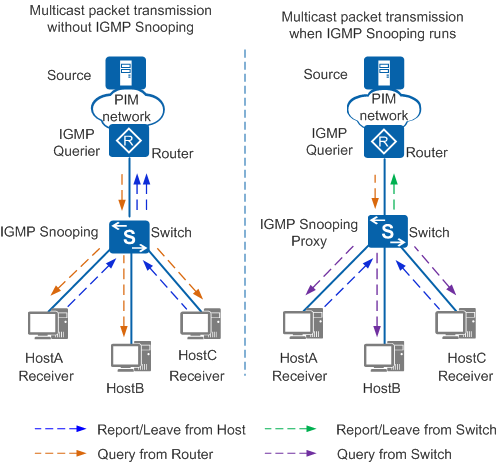IGMP Snooping Proxy
Fundamentals
To reduce the number of IGMP messages transmitted on network segments of user hosts, configure IGMP snooping proxy on a Layer 2 multicast device. The Layer 2 multicast device then sends IGMP Query messages to user hosts on behalf of the upstream Layer 3 device, and sends Report messages to the Layer 3 device on behalf of user hosts. A device configured with IGMP snooping proxy functions as a host for its upstream device and a querier for downstream hosts.
In Figure 1, when the switch runs IGMP snooping, it transparently forwards IGMP Query messages to the hosts, and Report/Leave messages to the upstream router. When numerous hosts exist on the network, redundant IGMP messages increase the router's burden.
With IGMP snooping proxy configured, the switch can terminate IGMP Query messages sent from the router and IGMP Report/Leave messages sent from downstream hosts. When receiving these messages, the switch constructs new messages to send to the router or hosts.
After IGMP snooping proxy is deployed on the Layer 2 device, the Layer 3 device considers that it interacts with only one user. The Layer 2 device interacts with the upstream device and downstream hosts. The IGMP snooping proxy function conserves bandwidth by reducing IGMP message exchanges. In addition, IGMP snooping proxy functions as a querier to process protocol messages received from downstream hosts and maintain group memberships. This reduces the load of the upstream Layer 3 device.
Implementation
A device that runs IGMP snooping proxy sets up and maintains a Layer 2 multicast forwarding table and forwards multicast data to hosts according to this multicast forwarding table. Table 1 describes how the IGMP snooping proxy device processes IGMP messages.
IGMP Message |
Processing Method |
|---|---|
IGMP General Query message |
The Layer 2 device sends the IGMP General Query message to all ports in a VLAN except the port that has received the message. The device generates an IGMP Report message based on the group memberships and sends it to all router ports. |
IGMP Group-Specific/Group-Source-Specific Query message |
The Layer 2 device drops the message. |
IGMP Report message |
|
IGMP Leave message |
The Layer 2 device sends a Group-Specific Query message to the port that receives the IGMP Leave message. The Layer 2 device sends an IGMP Leave message to all router ports only when the last member port is deleted from the forwarding entry. |
